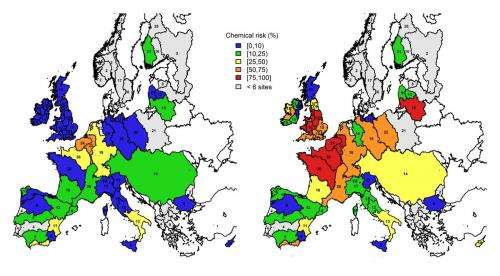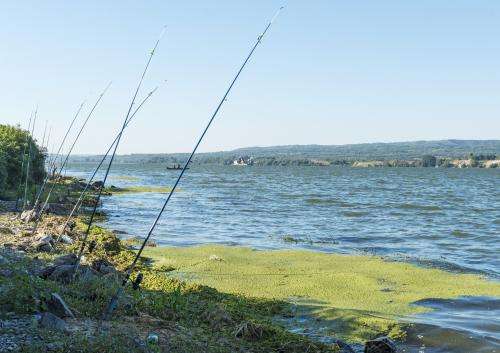June 17, 2014 report
European freshwater chemical pollution study shows dismal signs

(Phys.org) —Researchers in Europe have completed a study that provides evidence of how chemicals are threatening the ecological integrity of water bodies on a continental scale. New Scientist called this study of organic chemicals' impact on waterways as the most extensive survey yet of pollution in the major river basins on the continent. John Metcalfe of CityLab called the results of this broad analysis of waterways as dismal. Both emphases are correct. The study, "Organic chemicals jeopardize the health of freshwater ecosystems on the continental scale," was presented online Monday in the Proceedings of the National Academy of Sciences (PNAS), published ahead of print. The authors, from Germany, France and Switzerland, were aware of previous small scale studies exploring the impact of chemicals on stream and watershed scales, in the form of local and regional studies, but they saw a need for such an examination on larger spatial scales.
They presented a comprehensive chemical risk assessment on this larger scale. The assessment encompassed three major organism groups in freshwater ecosystems: fish, invertebrates, and algae, represented by Pimephales promelas, Daphnia magna, and Pseudokirchneriella subcapitata. What turned out to be the risks? Researcher Egina Malaj and colleagues analyzed government-monitored water quality data from 4,001 monitoring sites throughout Europe. (Malaj is from the Helmholtz Center for Environmental Research in Leipzig, Germany.) They measured concentrations of 223 different organic chemicals, according to New Scientist, having downloaded the monitoring data for the chemicals at the 4001 testing sites across the continent. The authors wrote that "Organic chemicals were likely to exert acute lethal and chronic long-term effects on sensitive fish, invertebrate, or algae species in 14% and 42% of the sites, respectively."
Out of the 223 chemicals monitored at the study sites, which posed the greatest chemical risks? Pesticides, tributyltin, polycyclic aromatic hydrocarbons, and brominated flame retardants were the major contributors to the chemical risk. One especially troubling finding was that chemical concentrations were potentially lethal at 14 percent of sites, levels high enough to kill aquatic species. New Scientist said that, in addition, "42 per cent of the sites may have subtler problems. The concentrations of organic chemicals were not immediately lethal, but could cause longer-term damage, such as impacts on breeding or increased vulnerability to disease."

One especially troubling finding was that chemical concentrations were potentially lethal at 14 percent of sites, levels high enough to kill aquatic species. New Scientist said that, in addition, "42 per cent of the sites may have subtler problems. The concentrations of organic chemicals were not immediately lethal, but could cause longer-term damage, such as impacts on breeding or increased vulnerability to disease."

The authors said, "Notwithstanding the high-quality data used for this analysis, the retrospective risk assessment presented here most likely underestimated the real risk of chemicals." The results overall suggested a number of environmental protection measures may be needed to address the continent-wide effects of such pollution. "The most important message from our study is that chemical pollution is a large-scale, not just local problem," Ralf Schäfer, the senior author and ecotoxicologist, said in New Scientist. The authors wrote that new frontiers in pollution prevention should be promoted, along with new approaches in communication and education.
More information: Organic chemicals jeopardize the health of freshwater ecosystems on the continental scale, PNAS, www.pnas.org/cgi/doi/10.1073/pnas.1321082111
Abstract
Organic chemicals can contribute to local and regional losses of freshwater biodiversity and ecosystem services. However, their overall relevance regarding larger spatial scales remains unknown. Here, we present, to our knowledge, the first risk assessment of organic chemicals on the continental scale comprising 4,000 European monitoring sites. Organic chemicals were likely to exert acute lethal and chronic long-term effects on sensitive fish, invertebrate, or algae species in 14% and 42% of the sites, respectively. Of the 223 chemicals monitored, pesticides, tributyltin, polycyclic aromatic hydrocarbons, and brominated flame retardants were the major contributors to the chemical risk. Their presence was related to agricultural and urban areas in the upstream catchment. The risk of potential acute lethal and chronic long-term effects increased with the number of ecotoxicologically relevant chemicals analyzed at each site. As most monitoring programs considered in this study only included a subset of these chemicals, our assessment likely underestimates the actual risk. Increasing chemical risk was associated with deterioration in the quality status of fish and invertebrate communities. Our results clearly indicate that chemical pollution is a large-scale environmental problem and requires far-reaching, holistic mitigation measures to preserve and restore ecosystem health.
Journal information: Proceedings of the National Academy of Sciences
© 2014 Phys.org



















